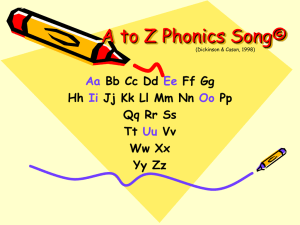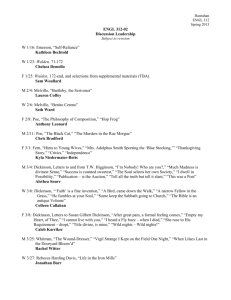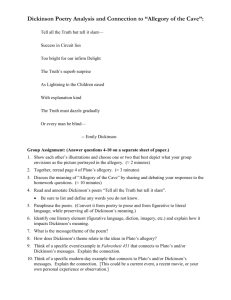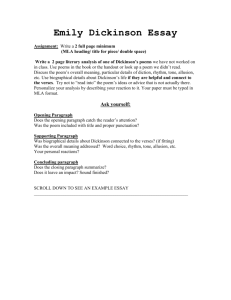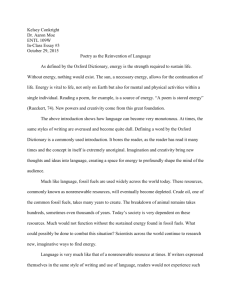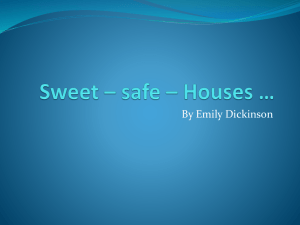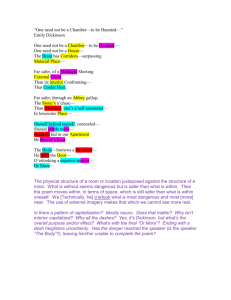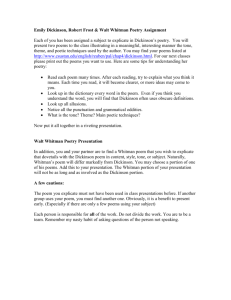Being in the Body
advertisement
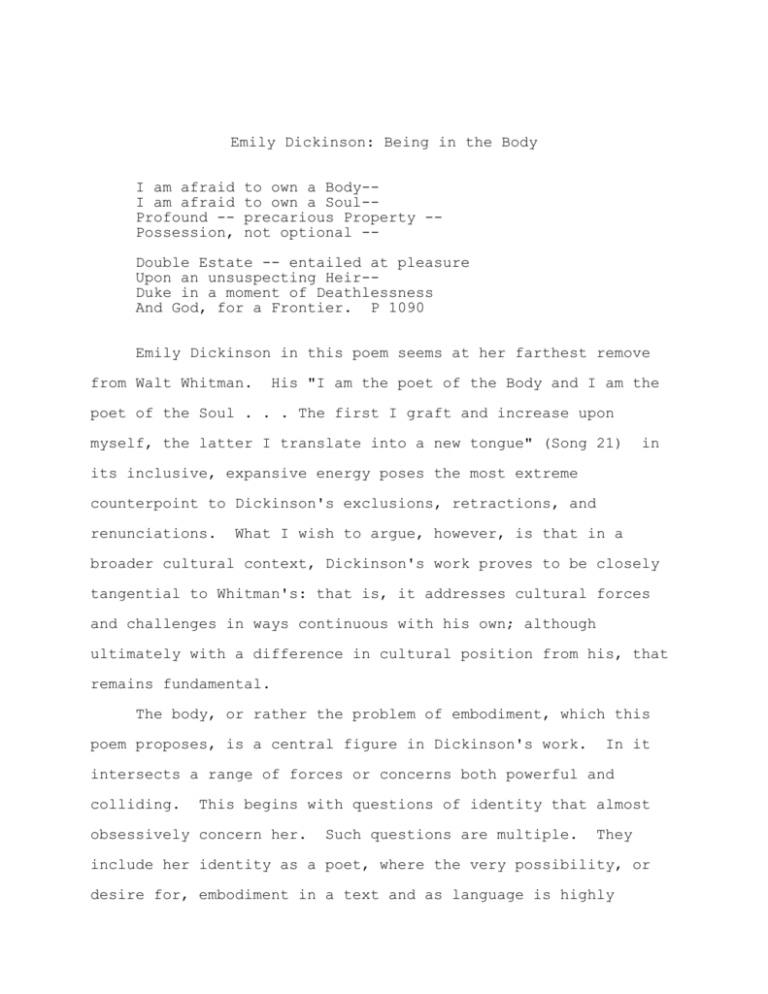
Emily Dickinson: Being in the Body I am afraid I am afraid Profound -Possession, to own a Body-to own a Soul-precarious Property -not optional -- Double Estate -- entailed at pleasure Upon an unsuspecting Heir-Duke in a moment of Deathlessness And God, for a Frontier. P 1090 Emily Dickinson in this poem seems at her farthest remove from Walt Whitman. His "I am the poet of the Body and I am the poet of the Soul . . . The first I graft and increase upon myself, the latter I translate into a new tongue" (Song 21) in its inclusive, expansive energy poses the most extreme counterpoint to Dickinson's exclusions, retractions, and renunciations. What I wish to argue, however, is that in a broader cultural context, Dickinson's work proves to be closely tangential to Whitman's: that is, it addresses cultural forces and challenges in ways continuous with his own; although ultimately with a difference in cultural position from his, that remains fundamental. The body, or rather the problem of embodiment, which this poem proposes, is a central figure in Dickinson's work. In it intersects a range of forces or concerns both powerful and colliding. This begins with questions of identity that almost obsessively concern her. Such questions are multiple. They include her identity as a poet, where the very possibility, or desire for, embodiment in a text and as language is highly Body, p. 2 ambivalent; her identity as a woman, both in terms of inhabiting a woman's body and of womanhood as a figure for the body; her religious identity, in a broad metaphysical context of ambivalence towards material and temporal embodiment (an aspect of Dickinson's work which I feel has been quite neglected); and finally, her identity as an American, in terms of definitions of selfhood as these have peculiarly taken shape within the history of the United States. In this poem, what I wish first to emphasize is the difficulty and obduracy of the text. Indeed, as often occurs in Dickinson, the text becomes more recalcitrant and opaque the longer one works with it. in many ways my subject. It is this textual obduracy which is Dickinson poems require the closest textual attention; and can not easily be cited as evidence in an argument, since closer textual work almost always uncovers further readings and implications not easily resolved or subsumed into a summary statement. between Dickinson texts. This is the case both within and I feel that it is one of the first tasks of Dickinson criticism exactly to acknowledge and consider this textual multiplicity in Dickinson's work: but less as indeterminacy or open-ended ambiguity or (only) aesthetic ploy than as the deployment and mutual confrontation between personal and cultural forces which are deeply at stake for her. What often occurs, as here, is the text's proposing a number of figural systems, on a number of different levels. These Body, p. 3 include sets of images; syntactic and formal relationships; off rhyme and other disjunctive compositional patterns; and multiple senses or usages within individual words, each of which acts as a place of intersection between several possible references. result is a highly structured text of extreme density. The On the one hand, Dickinson's poems invite or promise a complex orchestration of the different figural levels she deploys. However, close attention to her language often discloses that the figural levels ultimately do not fully correlate with one another. A process or unfolding of what might be called figural mismatch, or slippage, instead occurs. The text, that is, promises to set up elaborate metaphorical analogues, reminiscent of the intercrossing figural levels of Renaissance Metaphysical poetry. Different levels of experience seem to be images or metaphors for each other, to represent each other in an architectonic structure. This promise or implication of systematic, tight, even highly ornate correspondences, however, is then stymied. Instead, what is experienced is a resistance to just such correspondences. Figural correlation becomes figural slippage. This figural slippage poses firstly a formal and textual challenge. In the case of P 1090, the challenge unfolds through complications of analogy. The (fear of) owning a body and/or soul -- and I think it is important that the soul is not privileged here; that Dickinson does not prefer to own a soul Body, p. 4 without a body -- is in itself proposed as a metaphysical or religious topic. But it is developed in a language that is also economic: property, posession, estate. At the same time, the structure of economy becomes increasingly gendered. Entailment is a specifically male form of inheritance; and "Heir" and "Duke" are both specifically male forms of inheritor. But of course "entailed" is at the same time a philosophical term, continuous with the poem's metaphysical opening, and resumed explicitly in the concluding reference to "God." The poem thus introduces three levels to start: a metapysical one; an economic one; and a gendered one. And, in the familiar structure of metaphorical transfer or analogy, we expect that these three will be brought into a relationship of mutual representation. not fully occur. peculiar. But such correlation or transference does The poem's conclusion, for example, is It oddly obtrudes spatial imagery for a God that by definition is spaceless, indeed, is utterly without and beyond body. This of course is unique neither to this poem nor to Dickinson. As Geoffrey Hartman remarks on a poem with certain similarities to this one ("My Journey had Advanced" P 615), "the very idea of Eternity. . . cannot be represented by space and time categories [although] this does not explain why Emily Dickinson is haunted by a conception impossible to depict."i In our poem, too, the spatial imagery, while seemingly an attempt at locating God or locating the speaker in relation to God, at least Body, p. 5 in metaphor; in effect is no less dislocating, or dissolving into illocality. For the conclusion points, as Dickinson so often does, in at least two incompatible directions. God as a frontier in one sense promises consolation, as the boundary or bounding principle giving shape or reference to a life. In another sense, this frontier-God or God as frontier may be bounding as menace -- inescapable, limiting, imprisoning. An American usage enters here. As Sacvan Bercovitch points out, the frontier only acquired its meaning of unlimited and expansive possibility in the American context; in Europe it had meant a fixed and inexorable boundary.ii The poem plays on both senses. The second, limiting possibility recalls that the poem opens in fear as to owning a body and/or a soul, a fear tied to just these questions of imprisonment or definition. Terms of hesitation or discomfort then continue through the text, with its sense of "precarious" property, imposed ("not optional"), on one unprepared for it ("unsuspecting"). And yet, this language of hesitation appears alongside, or may itself comprise, expressions of exuberance. The property is also "Profound;" in this sense its fragility (as "precarious") may be precious. "Unsuspecting" may suggest something unearned, but therefore all the more gracious; or unhoped for, in humility. These double possibilities come to special focus in the line: "Duke in a moment of Deathlessness." The title "Duke" may be a kind of play on Dickinson's own name, a sign of her nobility. And Body, p. 6 "Deathlessness" suggests just that immortality or transcendence or sublimity which the property, as precious inheritance, could bestow. And yet: this "Deathlessness" lasts but a moment; and "Duke" is a title beyond Dickinson's gender, and is also alien to American social structures and laws of inheritance.iii Indeed, the whole structure of property she evokes is one which doubly does not apply to herself: as a woman and as an American. Dickinson seems to take away with one hand what she offers with the other. Economy or history remains in the poem, however, figural representions of the text's initial (and then final) terms. These are terms of religion, although as we will see, not exclusively so. The poem almost encapsulates Dickinson's stance towards her religious inheritance in general, including its hierarchy of body and soul, or soul against body. That is, she is profoundly torn regarding her own inheriting of this tradition. There is an extent to which the Christian metaphysical tradition inevitably informs her work, and indeed, I would argue, never ceases to do so. I do not think Dickinson ever entirely divests herself of the Christian, and specifically Calvinist, context in which she grew up in Amherst, although her relation to it is often one of rebellion and contention. The very fact that poems of more or less definite religious displacement or conflict take their place alongside poems of more or less religious devotion and conformity (and the arrangement is not simply chronological: there is no clear evolution in Body, p. 7 Dickinson's work from one stance definitively into another) argues, it seems to me, for a continuous metaphysical pressure on her.iv Adopting the trope of this poem, Dickinson's work as a whole may be called a "Double Estate," double and indeed contradictory in its orientation. It at once asserts a possible faith and no less painfully questions and denies such faith. This is the case, in Dickinson, not only regarding religion. The question is: what is at issue, in her acceptance or her rejection, in her conformity and her resistance? What is her fear, and what is her desire? We have come to that crux of doubling, of texts as somehow at odds or at cross-purposes in their internal structures and their mutual relationships, with which every Dickinson commentator ultimately must grapple. Dickinson texts, as here, both say and unsay; claim and disclaim; desire and decline; offer and retract; assert and deny; defend and attack; gain and lose; define and circumvent definition.v Whatever stance a poem seems to pursue, by the end it seems no less to unravel. Or, oppositional forces, or commitments, which are brought into headlong confrontation, seem to demand exclusive choices and sacrifice, often painfully, and almost always at great cost. In my own reading of this characteristic doubling or ambivalence, I see Dickinson's as a powerful agonistic voice, caught between incompatible visions, assertively critical of each of them, unable to resolve their contradictions nor yet to reside Body, p. 8 comfortably in any of their competing claims. It is a poetry of anger, dissatisfaction, and critique; also of mocking, even wicked wit; and also of sublimity, although often at painful cost. This is to say that I do not think attempts to reconcile Dickinson's dualities as though she desires not to desire, or successfully converts restrictions and losses into a means of grace, do justice to the profound conflicts which Dickinson's verse seem to me to dramatize.vi things both ways. Dickinson can really not have Nor do I see her doublings as coexisting in a kind of suspended judgment or disinterested uncertainty, a detached contemplation of abstract possibilities, or even as aesthetic strategies, although I do think her stances strongly implicate a theory, or role, for art. This brings me to a further level of figuration which P 1090 also proposes. The body and soul which Dickinson here on the one hand shies from, but on the other hand longs for, also can suggest her literary inheritance, as it becomes embodied in her language. Such imagery of embodiment for her own writing is proposed, obliquely or directly, in many poems. As she writes in one famous instance (in ways too complicated to explore here), the "Word" is made "Flesh" in poetry (P 1651).vii But Dickinson's stances towards textual, as towards other embodiments, tend to be, as in P 1090, profoundly agonistic. In another poem with much cross-imagery with P 1090, she says that "To own the Art within the Soul" is "to entertain/ with Silence as a Company" (P Body, p. 9 855). True art is associated with silence. In this privileging of silence, there is an element of the Romantic sublime such as Roger Shattuck has recently discussed, in which Dickinson's resistance to full realizations in both expression and experience may reflect less default than a "banquet of abstemiousness." Within the tenets of a Romantic Imagination, what- is- not always exceeds what- is, with poetry a dwelling in such further "possibility" (P 657).viii This structure of Romantic imagination as abstemiousness, or, to follow Harold Bloom's anatomy of it, as making negation of nature or experience the ground for poetic creativityix, is a vital force in Dickinson. But Dickinson's poetry further brings out the complicated relation between Romantic Imagination as negation and more traditional metaphysical structures. Romantic Imagination in its own way continues to privilege an unrealized sublimity over concrete realization or embodiment, including embodiment in language. On the other hand, this Romantic privilege refers not to a divine or dogmatic eternity, but to the further power and potential of the human imagination. The art work stands then as a positive sign to its own further productions, a promise which will never be completely fulfilled but which will ever open into still greater creative possibilities. Dickinson's verse I think also invokes and asserts such a Romantic sublimity, not unlike Whitman's. But in her case the possibilities of artistic imagination are chastened, as are its Body, p. 10 resources in the self, by gender and by metaphysical scruple. For one thing, the body and soul she fears and desires to inherit in P 1090 is that of a woman, who cannot be entailed Heir to a Ducal title. To be born into a woman's body is to be barred from such social resources of power. It is also to be precariously placed in metaphysical tradition, to be, if not barred, than subordinated within hierarchies of spiritual power, within the long association of the female with body and emotion, as against a spirituality and reason represented as male.x But to enter into an embodied estate is generally to come under the liability of death, that frontier Dickinson so perpetually met with face to face, whether defined by God or by nothingness. Against more ordinary usage, "estate" here is not immortality but mortality. Yet to enter the mortal estate is also a kind of birth. The "Double Estate" is, in effect, nothing other than selfhood, which the terms "Property" and "Possession" also evoke. The self is oneself proper, one's self-posession, one's self as one's own. But this double estate as body and soul situates Dickinson's self precariously indeed. Fear, or ambivalence, at owning a body and a soul resonates with centuries of metaphysical hierarchy, or suspicion, according to which embodiment in the material and temporal world somehow threatens, if it does not betray, essential nature -- indeed essence itself -- defined as intelligible, or spiritual, or eternal.xi Being in the body is in this context a kind of philosophical pun, or paradox. For in Body, p. 11 the philosophical tradition, body has stood as opposite to being, although also as its sign, if only in a partial, attenuated and to some extent treacherous way. Within metaphysical hierarchy, the two are not equally legitimate resources for her, nor are they necessarily or entirely mutually confirming. Here we glimpse some of the strained asymmetries that become evident in Dickinson's work. First, the ideologies of selfhood which Whitman or Emerson might pursue are a priori different for Dickinson simply because of her gender. As Joyce Appleby remarks, liberal individualism in many, many of its strictures presumes "the human personality [to be] male."xii For a woman within nineteenth century culture, to achieve one's selfhood is also to subordinate it, as daughter and wife (I would distinguish motherhood from these roles as its own, rather different category.)xiii This would frame a general ambivalence to achievement, poetic as otherwise, which can be located in restrictive gender roles for nineteenth century women. This equivocally gendered position also reaches beyond the social into the religious realm. The kinds of identification with the divine possible for Whitman or Emerson is from the outset impossible for Dickinson. Her self can not be a figure for God in the same way as theirs can, if only by virtue of a differently sexualized relationship, with all that this implies regarding authority and subordination, self-fulfillment and self-denial. And both the social and religious economies in turn implicates material ones. Body, p. 12 "Estate" itself in the poem is a metaphysical/ material pun; while the property-structure implicit in the poem reaches beyond selfhood to ownership (another pun that underscores their intimate relationship, especially in America). I cannot resist noting that several of the poems immediately surrounding this one in its fascicle set explicitly center in economic imagery. In one, Dickinson's "letter" from the world reports the stock market's "advance and Retrograde" (P 1089). In another, she again equates her self- "Possession" as "Me" with the "Riches I could own" in "Dollars," an "Earldom," and "Income" (P 1093). The poetic prospect opens towards questions of how far a self owns itself under God, how far woman owns herself in relation to man, and also, how far identity in America is established through ownership, possession, and inheritance. There remain, finally, questions of her own art, in consonance or contrast with the other forms of owning the poem evokes. Dickinson, I would argue, is extremely self-conscious of the religious residue in Romantic language claims, and of its complicating effects. This is evident in any number of her texts, in which true art, and indeed truth itself, is aligned with silence as the sign of spirit as against the body of language. In the poem I mentioned earlier, "To own the Art within the Soul," the truly 'owned' art is one of "Silence," developed through an imagery of nakedness or disembodiment ("unfurnished Circumstance"); and also in imagery of spiritual Body, p. 13 property and selfhood: "Possession is to One / As an Estate perpetual / Or a reduceless Mine" (P 855). Here, too, economic puns emerge through "Possession," "Estate," and "Mines," assoiccating selfhood with valuable property. "Mines" is in fact a recurring pun in Dickinson, evoking property and selfhood and a true art as inner word which, as one poem puts it, when it "fails" to be exacted is "A Rapture as of Legacies -- / Of introspective Mines," P 1700). Dickinson in such texts brings together, but also breaks apart, the multiple levels of her identity, in terms of gender, art, religion, and history. Not every Dickinson poem brings all of these constructions together or situates them in the same ways. Sometimes gender is the prevailing structure, sometimes art, sometimes metaphysics. History is almost always brought to bear indirectly, often through an imagery of economy that is surprisingly pervasive. But, while Dickinson gathers into her texts these different engagements, seeming to promise they will serve as figural correlatives for each other; what often occurs instead is that they come into collision through ambivalent or contradictory representations. slippage. Instead of correlation, there is That the body, as in P 1090, should be a peculiar crossing point for these correlations and collisions accords with its equivocal status within the traditions of her culture. Both Dickinson's biography and her art are strangely marked with this equivocation. Her acts of reclusion -- of herself in her house Body, p. 14 and in her white dress; and of her poems, in her refusal to publish them, while nevertheless writing and collecting them in her fascicles -- can be seen as acts of profound ambivalence towards owning a body and a soul, a way of being in the worlds of time and text and yet withholding herself from them. Poetry, as she writes in another famous poem, is a "Corporeal illustration" whose "Publication would be the "auction of the Mind of Man" (P 709). This wonderful poem offers another complex structure of multiple figures which do not quite match: where publishing is aligned, in economic terms, with a foul auction; as against a "white" purity devoted, in religious language, to a "white" creator; with a strange gendering which represents Dickinson's own, quite distinctive terms of creation and concealment with those of the "Mind of Man." In this poem, it is as if Dickinson wants both to find linguistic body for her poetry and yet also not so to limit it; just as, in her white dress, she wants both to be in the body and to be bodiless; perhaps to be gendered and yet to be genderless; to be in the world and yet to be in the spirit, where these two remain in some sense antithetical. This recalls the main text I have been considering, P 1090: "I am afraid to own a Body/ I am afraid to own a Soul." There, too, Dickinson seems at once to negate and to affirm ownership, selfhood, God, and art. She hopes to inherit a precious (male) legacy; she fears to inherit a precarious estate. God is a sublime frontier of ever opening possibility or desire; God is a Body, p. 15 repressive boundary. Language is positive embodiment; language is betrayal, liability, and confinement. These counterposing directions, I want to argue, represent severe and often painful conflicts; conflicts, moreover, not only personal to Dickinson, but broadly reflecting her culture. Dickinson's texts are scenes of cultural crossroads, situated within the many and profound transitions taking place around her. These include the changing, indeed the tremendously dynamic status of women in nineteenth century America; the no less dynamic countercrossing between religious tradition and secularizing forces; and emerging re-definitions of selfhood, both in art and in society, through complex intellectual, social and economic changes as the century evolves. In my earlier work on Dickinson, I considered the Civil War as a highly volatile moment in which such cultural tensions exploded. I did so against the resistance to history which critical discussions of Dickinson's poetry so often observe, responding no doubt to the poetry's own obliqueness. While it is impossible to elaborate this complex cultural moment here, I do wish to argue one specific point of context. The figural orders which Dickinson so forcefully evokes and interrupts in her poetry are those basic, and precious to her surrounding culture. Its origins may be traced to the peculiar modes of Puritan religious and natural typologies, where the events of history and the world were interpreted as signs of divine intention. This figural or Body, p. 16 typological impulse did not simply die in the nineteenth century, but rather underwent transformations whereby the events of America continued to be understood as moments in a universal drama of redemption, even if such redemption was increasingly claimed for history rather than eternity. Not least, figural orders continue to structure a highly metaphorical Romantic art, through a typology of nature and the imagination, centered in the self but whose circumference extended infinitely through spiralling images and tropes of productive power and creativity. As Emerson writes in "Circles," using Pauline language: "We learn that God IS; that he is in me; and that all things are shadows of him" (172). Dickinson inherits this figural order and method of interpreting her world, with its implicit claims that the various levels of experience and of identity are mutually confirming and culturally coherent. We feel this assumption or claim very strongly in Whitman. Whitman, in his stupendous and extravagant figural energy, is intent on creating a poetry, and indeed an America, in which each aspect of experience can serve as a figural transformation, or as he calls it, translation, of each. Material prosperity is a sign of spiritual possibility. The self is a sign of a community of love; this American world is a constantly evolving figure of worlds to come; each poem generates and transforms into further poetries of Romantic imagination; and the body is articulate sign for the soul, or, as he writes in the Body, p. 17 quotation with which I began, "I am the poet of the Body and I am the poet of the Soul . . .The first I graft and increase upon myself, the latter I translate into a new tongue" (Song 21). In my reading of Whitman, this figural project is far from secure. Indeed, it is haunted with a fearful skepticism that such a figural poetics of America is not quite the case; that these ongoing correlations do not in fact hold. In the case of Dickinson, such skepticism dominates and intrudes directly into the figural construction. She too ranges across a variety of levels of language and experience, in a textual architecture which seems to correlate one with the other. But then the correspondences slip, or break apart, or contradict, or misalign. Or, they realign, but only at the cost of one of their commitments. To inherit as Duke is not to inherit as woman. is welcomed, but also shunned, as frontier. God Sublime imagination, or religious immortality, is announced: but not necessarily as coherent figures for each other, and elusively, for only a moment; seeming almost to be produced by language construction, as if "Deathlessness" comes into being through the abstract compounding of its word. The bodies of the self and of language are both claimed and feared. These analogical slips are not, in my reading, signs of a loss of linguistic control or of mere incoherence. They, rather, textually enact a kind of cultural slippage in which a female gender complicates or contradicts assertions of an American or Romantic selfhood; material progress Body, p. 18 in the world subverts or opposes, rather than realizing spiritual longings; self-fulfillment contests with self-denial; and body remains in tension against soul, including poetic embodiment as against some pure artistic essence. There are many entries into Emily Dickinson's verse: psychobiograhy, Romantic aesthetics, philology, formalist composition, history, religion, gender. work, however, not only annexes each of these. It does so in ways that explore the complex and often tense relationships between these different arenas. The result is a work that remains at once formally explosive and culturally engaged: a poetry not simply of evasions, but of confrontations. Her Body, p. 19 Notes Body, p. 20 Shira Wolosky: Emily Dickinson: Being in the Body 1) I am afraid to own a Body-I am afraid to own a Soul-Profound -- precarious Property -Possession, not optional -Double Estate -- entailed at pleasure Upon an unsuspecting Heir-Duke in a moment of Deathlessness And God, for a Frontier. P 1090 2) To own the Art within the Soul The Soul to entertain With Silence as a Company And Festival maintain Is an unfurnished Circumstance Possession is to One As an Estate perpetual Or a reduceless Mine. P 855 3) Myself can read the Telegrams A Letter chief to me The Stock's advance and Retrograde And what the Markets say The Weather -- how the Rains In Counties have begurn. 'Tis News as null as nothing. But sweeter so-- than none. P 1089 4) Because 'twas Riches I could own, Myself had earned it -- Me, I knew the Dollars by their names -It feels like Poverty An Earldom out of sight to hold, An Income in the Air, Possession -- has a sweeter chink Unto a Miser's Ear P 1093 5) To tell the Beauty would decrease To state the Spell demean-There is a syllable-less Sea Of which it is the sign-My will endeavors for its word And fails, but entertains A Rapture as of Legacies-Of introspective Mines -- P 1700 Body, p. 21 P 709 Publication -- is the Auction Of the Mind of Man -Poverty -- be justifying For so foul a thing Possibly -- but We -- would rather From our Garret go White -- Unto the White Creator -Than invest -- Our Snow -Thought belong to Him who gave it -Then -- to Him Who bear Its Corporeal illustration -- Sell The Royal Air -In the Parcel -- Be the Merchant Of the Heavenly Grace -But reduce no Human Spirit To Disgrace of Price -i.Geoffrey Hartman, "The Voice of the Shuttle," Beyond Formalism, (New Haven: Yale University Press, 1970), p. 349. ii.Sacvan Bercovitch, The Rites of Assent (New York: Routledge, 1993), p. 51: "As for boundaries...political leaders revers[ed] the meaning of frontier. Traditionally, a frontier was a border dividing one people from another. It implied differences between nations. [Am] could hardly accept [this] restriction as permanent. gSo they effected a decisive shift in the meaning of frontier, from barrier to threshold.... to mean a figural outpost, the outskirts of the advancing kingdom of God. iii. Although entailment structures of inheritance were offically abolished only in 1791, they had never taken root in the New World. In southern colonies such as Maryland the Carolinas Body, p. 22 (unlike in New England), attempts were made to establish a British structure of landed gentry. But these were on the whole unsuccessful regarding inheritance laws, and also inheritable titles of nobility, which were then specifically outlawed in the United States Constitution. The whole property structure the poem evokes is in fact one contested and rejected by American senses of individual independence, self-definition, equality, and personal mobility. See Carl Degler, Out of Our Past, (New York: Harper and Row, 1959), p. 103; 3-4; 44-45. Cf. Marshall Harris, Origin of the Land Tenure System in the United States (Ames, Iowa, 1953) p. 373. What of course took root in the South instead of fuedal forms of inherited nobility was the plantation system of slavery. iv. I think Eberwein is right to emphasize the importance of Dickinson's religious engagement; but I would not call Dickinson a "religious poet," as she does (p. 40), nor would I retain the basic structure of conversion from deprivation to transcendence in art if not religion, which continues to govern Eberwein's interpretation of Dickinson. Dickinson is a severe critic and skeptic of religion in its fundamental theological structures. But I would, in the continued pressure of these structures on her work, call her a poet of religious context. Strategies of Limitation. v. Suzanne Juhasz's article on "Reading Dickinson Doubly" clearly presents some of the methodological issues of such double implication in reading Dickinson texts. vi. Sharon Cameron, Choosing Not Choosing. A variant on her earlier book, Lyric Time, it nevertheless pursues same ahistoricist and deadlocked version of Dickinson. Gary Lee St in The Dickinsonian Sublime usefully underscores the importance of mastery in Dickinson, but also seems finally to argue that her project is not to have one. vii. I have discussed this poem and others that raise questions regarding the metaphysical status of language more fully in Emily Dickinson: A Voice of War New Haven: Yale University Press, 1984. viii.Roger Shattuck: New York Review of Books, June 20, 1966 5559? ix.See for example Harold Bloom, "The Central Man:" The Ringers in the Tower and "Emerson" Figures of Capable Imagination x. There are many discussions of this association of woman with body. See H. R. Bloch, Medieval Mysoginy; Judith Butler, Gender Trouble; etc. Body, p. 23 xi. For a full history of this ambivalence against the body and specifically its implications for attitudes towards language, see my book, Language Mysticism. xii.Joyce Appleby, Liberalism and Republicanism in the Historical Imagination, (Cambridge, Mass: Harvard University Press, 1992) p. 1. xiii. Most feminist readings of Dickinson focus on this point of subordination, either as a gendering of artistic power (Diehl) or as within nineteenth century culture (Dobson).
